Choosing a nearby membrane switch manufacturer can lower lead times and transportation costs.
Choosing a nearby membrane switch manufacturer can lower lead times and transportation costs.
Blog Article
Everything About Membrane Layer Switch: Recognizing Its Style and Capability
When you think of the control interfaces in modern devices, membrane switches frequently come to mind. These elements are much more than just switches; they blend design and functionality effortlessly. Understanding how they work and what makes them effective can alter your perspective on daily electronic devices. Yet, there are subtleties to their design and performance that you may not understand. Allow's discover what sets membrane switches over apart from various other control systems.
What Are Membrane Layer Buttons?

Their seamless nature makes them very easy to tidy and immune to dust and moisture, a crucial feature in many environments. Membrane layer buttons can likewise be personalized concerning shape, size, and graphics, allowing producers to create unique user interfaces tailored to certain items. And also, they're light-weight and thin, which aids in reducing the overall mass of gadgets. Overall, membrane layer switches play a significant function in enhancing customer experience across a wide array of applications.
Exactly How Membrane Switches Work
When you press a trick on a membrane switch, it turns on a straightforward yet effective system. membrane switch manufacturer. The leading layer, frequently made of adaptable material, pushes down onto a conductive layer beneath it.
You'll notice that the tactile feedback varies based on the button style, supplying either a soft click or a much more pronounced reaction. As soon as you launch the key, the membrane go back to its original position, reopening the circuit and quiting the signal. This process takes place almost immediately, ensuring a receptive customer experience.
Membrane buttons are preferred as a result of their resilience and resistance to dirt and wetness, making them optimal for different applications, from family devices to medical gadgets. Understanding this operation helps you value their extensive use.
Trick Parts of Membrane Buttons
Understanding the key parts of membrane buttons is essential for grasping their performance and design. The safety layer shields versus environmental factors and put on, expanding the switch's life expectancy. By recognizing these components, you'll gain insight right into exactly how membrane switches operate and their value in different applications.
Materials Made Use Of in Membrane Layer Switch Layout
The efficiency and durability of membrane changes heavily depend on the products used in their style. You typically come across polyester and polycarbonate as primary substratums as a result of their exceptional stamina and adaptability. These products resist scratches and chemicals, making them suitable for demanding atmospheres.
The conductive layers usually use silver or carbon, selected for their integrity and conductivity. membrane switch manufacturer. Silver offers remarkable efficiency, while carbon is an economical option. For the overlay, you may take into consideration a matte or glossy surface, depending upon your visual demands and customer experience
Adhesives play a necessary role as well; they bond layers safely and guarantee long life. Make sure to pick adhesives that withstand environmental variables like temperature and humidity. Lastly, don't ignore the significance of an excellent printing strategy for graphics, as it enhances both functionality and visual charm. Selecting the right materials will guarantee your membrane switch stands the test of time.
Layout Factors To Consider for Membrane Switches
While developing membrane layer switches, it's vital to take right into account various factors that influence their capability and customer experience. Begin by concentrating on the layout and switch size; make certain they're user-friendly and easy to browse.
Do not ignore the visuals layout; clear view it now labeling and shade comparison are considerable for visibility. Confirm your layout suits ecological aspects, like wetness or temperature variations, which might influence efficiency. Finally, bear in mind the value of testing models with actual users to gather feedback and make required modifications. This repetitive procedure helps you fine-tune the layout, verifying it meets both functional and aesthetic requirements efficiently. By carefully taking into consideration these components, you'll create a membrane layer switch that improves functionality and complete satisfaction.
Applications of Membrane Layer Buttons
Membrane layer switches are flexible parts found in various applications, from industrial tools to consumer electronic devices. You'll see their effect in machines that require resilient interfaces and in gadgets that gain from streamlined layouts. Understanding these applications assists you appreciate the performance and functionality of membrane switches in everyday technology.
Industrial Devices Usage
When you're looking to boost the capability of commercial tools, membrane buttons offer a reliable remedy that integrates durability with user-friendly style. These switches are ideal for extreme settings, providing resistance to dust, dampness, and chemicals. You'll discover them in control panels for manufacturing devices, cooling and heating systems, and clinical devices, where precision and responsiveness are crucial. Their reduced account suggests they fit flawlessly right into numerous tools, conserving beneficial area while keeping convenience of use. With personalized graphics and backlighting options, you can create an instinctive user interface for operators, boosting performance and security. Plus, their long life-span decreases upkeep costs, making them a wise investment for your commercial applications. Accept membrane switches to enhance your operations and boost overall efficiency.
Consumer Electronic Devices Combination
In the domain name of customer electronics, membrane switches play a necessary function in improving individual communication and tool capability. Membrane switches also guarantee resilience and resistance to dust and dampness, expanding the life expectancy of your electronics. By picking membrane layer switches, you improve not just the performance yet likewise the style of your gadgets, making everyday interactions smooth and delightful.
Benefits and Downsides of Membrane Buttons
While membrane layer switches supply a series of advantages, they also feature some disadvantages that you ought to consider. One considerable advantage is their small design, making them ideal for space-constrained applications. They're additionally affordable, supplying a durable solution with a reduced manufacturing cost. In addition, their smooth surface is very easy to tidy, boosting hygiene in settings like healthcare facilities.

Membrane switches can have a shorter lifespan contrasted to mechanical switches, especially under hefty usage. They can additionally be much less tactile, which may influence user feedback during operation. Stabilizing these pros and disadvantages will certainly help you identify if membrane switches are the best fit for your task.
Frequently Asked Questions
The Length Of Time Do Membrane Changes Usually Last?
Membrane switches over normally last between 5 to one decade, depending upon use and ecological problems. You'll desire to evaluate aspects like wear, exposure to dampness, and temperature fluctuations to determine their long life properly.
Can Membrane Switches Over Be Custom-made for Certain Designs?
Yes, you can personalize membrane layer buttons to fit certain designs (membrane switch manufacturer). You'll have the flexibility to choose colors, forms, and formats that match your job's requirements, ensuring they mix flawlessly with your general aesthetic
What Is the Price Range for Membrane Layer Switch Manufacturing?
The expense range for membrane layer button manufacturing commonly falls between have a peek at this site $1 and $10 go to my site per device, relying on factors like style complexity, amount, and materials. You can get quotes from producers to discover the best choice.

Are Membrane Changes Waterproof or Resistant?
Membrane switches can be created to be water resistant or resistant, depending upon materials made use of and building and construction approaches. If you require them for wet environments, guarantee you specify those needs throughout the design process.
Just How Do Membrane Switches Compare to Typical Switches?
Membrane layer switches are typically thinner and more versatile than typical switches, providing a smooth design. They're typically easier to clean and integrate, however might not supply the responsive responses you're used to with mechanical options.
Final thought

Report this page